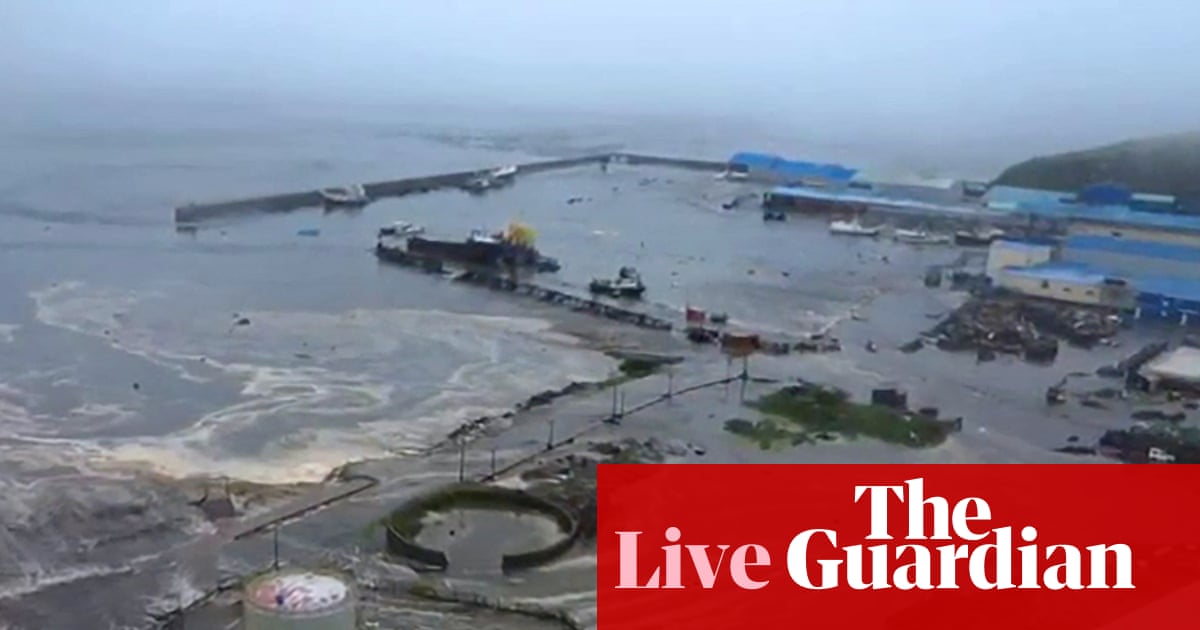Authorities ordered evacuations on Ecuador and Chile’s Pacific islands on Wednesday, after the massive 8.8 magnitude earthquake triggered tsunami warnings across the Pacific Ocean.
Residents and tourists on Chile’s Easter Island, located some 3,700 km (2,300 miles) off South America’s western coast, evacuated to a church on higher ground, while evacuations began along the mainland’s Pacific coast.
In Ecuador’s Galápagos Islands, some 970 km (600 miles) west of the mainland, the government ordered that people living in vulnerable coastal areas make their way to safe zones established by the country’s emergency management agency.
Key events
Please turn on JavaScript to use this feature
Summary
Tsunami alerts remain in effect in coastal parts of Chile, Ecuador, Peru and Colombia, and for Papua New Guinea, Solomon Islands and Vanuatu, following the massive 8.8 magnitude earthquake off Russia’s far eastern coast – one of the strongest ever recorded – on Wednesday. Most earlier warnings were lifted or downgraded in most other parts of the world as the day went on, including for Japan, the US, Russia, the Philippines, and others, after the impact of the water surges was less than initially feared.
Authorities ordered evacuations from vulnerable coastal areas to safe zones on Ecuador and Chile’s Pacific islands on Wednesday, after the massive 8.8 magnitude earthquake triggered tsunami warnings across the Pacific Ocean. Waves recently begun to hit Ecuador’s Galápagos Islands with heights of about 1 meter and 0.4 meters were reportedly recorded in the islands of Baltra and Santacruz. Residents and tourists on Chile’s Easter Island evacuated to a church on higher ground, while evacuations began along the mainland’s Pacific coast. Chile also evacuated five prisons due to their location at low elevations.
Meanwhile in French Polynesia, local authorities lifted the tsunami alert in the remote Marquesas Islands. They said people could return to their homes, but should remain cautious. Tsunami waves had begun hitting early in the day, but were smaller than initially feared, authorities said.
In the US, major flooding had been avoided in the northern California community of Crescent City that experienced the highest tsunami waves on the west coast (around 8 feet tall), the city manager, Eric Wier, said. “It was a long night for all of us,” he said. “We were fortunate this time.”
You can read our latest news story here:
Updated at 14.34 EDT
Chile is evacuating five prisons as the country remains on high alert for possible tsunamis.
Senapred, Chile’s national disaster response agency, said in a statement on their website that all five are being evacuated due to their location at low elevations.
The inmates will be transferred to other prisons as part of Chile’s natural emergency protocol, interior minister Álvaro Elizalde told CNN Chile.
Waves have started to hit Ecuador’s Galapagos Islands, according to data from the Pacific Tsunami Warning Center (PTWC) reported by CNN.
Wave heights of about 1 meter and 0.4 meters were reportedly recorded in the islands of Baltra and Santacruz.
ShareTsunami advisories cancelled for California, Oregon and Washington coasts
Tsunami advisories have been cancelled for coastal areas of California – from Ragged Point to Humboldt/Del Norte – Oregon and Washington.
ShareTsunami alert lifted in Marquesas Islands in French Polynesia
Local authorities lifted the tsunami alert in the Marquesas Islands in French Polynesia on Wednesday, Reuters repors, and said people could return to their homes, but said residents should remain cautious.
Tsunami waves had begun hitting early on Wednesday, but were smaller than initially feared, authorities said.
The High Commission of the Republic in French Polynesia said wave heights had reached 1.50 metres, down from a previous forecast of up to 4 metres. Additional smaller waves were expected in the coming hours, officials said.
Elsewhere in French Polynesia, wave heights were expected to remain below 30cm. However, residents are urged to stay away from shorelines and river mouths.
The Marquesas Islands, among the most remote in the world, have a population of approximately 9,500, according to a 2022 census. French Polynesia’s five archipelagos comprise 118 islands but have a total land area of only about 4,200 sq km.
There have been around 125 aftershocks of 4.4-magnitude or greater near Russia since the 8.8-magnitude earthquake struck off the country’s coast, data from the US Geological Survey shows.
Strong aftershocks continue to rock the region, with a 6.4-magnitude one striking some 200 miles south-west of the epicenter of yesterday’s quake at about 11am ET on Wednesday.
Aftershocks are usually strongest shortly after the main earthquake and lessen as time goes on.
ShareEaster and Galápagos Islands evacuate coastal areas as tsunami warnings rattle Pacific
Authorities ordered evacuations on Ecuador and Chile’s Pacific islands on Wednesday, after the massive 8.8 magnitude earthquake triggered tsunami warnings across the Pacific Ocean.
Residents and tourists on Chile’s Easter Island, located some 3,700 km (2,300 miles) off South America’s western coast, evacuated to a church on higher ground, while evacuations began along the mainland’s Pacific coast.
In Ecuador’s Galápagos Islands, some 970 km (600 miles) west of the mainland, the government ordered that people living in vulnerable coastal areas make their way to safe zones established by the country’s emergency management agency.
ShareWhere do tsunami alerts, warnings and advisories stand now?
Tsunami warnings are still in effect for:
Chile: upgraded its tsunami warning for most of its Pacific coast to the highest level
Easter Island: residents told to evacuate to safe zones
Colombia: issued a red alert in its northeastern Chocó and Nariño regions. Officials have called for evacuation of beaches and low-tide areas
Peru: issued a tsunami alert for its Pacific coastline
Tsunami alerts also remain in effect for:
French Polynesia: issued a tsunami alert for the Marquesas Islands archipelago
Galápagos Islands: visitor sites temporarily closed amid tsunami alert, and precautionary evacuation of vulnerable coastal areas such as beaches, docks, and other low-lying areas ordered
Papua New Guinea, Solomon Islands and Vanuatu
Tsunami advisories are in effect for:
Mexico: authorities issued a tsunami advisory for its Pacific coast as a preventative measure
Japan: lifted all tsunami warnings, however a tsunami advisory remains in effect for Pacific coast regions from Hokkaido to Kyushu
US: tsunami warnings have been downgraded but advisories remain in effect in parts of California, Hawaii, Alaska and Oregon
Tsunami warnings and advisories lifted in:
Japan: Japan has lifted all tsunami warnings, according to the country’s meteorological agency
Philippines: canceled a tsunami advisory that was issued for several coastal communities across the country
Russia: authorities in the far eastern Kamchatka peninsula said a tsunami warning had been lifted, more than 11 hours after the 8.8 magnitude earthquake prompted evacuations
Canada: tsunami advisory canceled for British Columbia coast
Guam and the Northern Mariana Islands
Locations across Micronesia, Australia and New Zealand are also in the clear
Updated at 12.31 EDT
California city manager says ‘it was a long night’ but major flooding avoided
In the US, the northern California beach community that experienced the highest tsunami waves on the west coast has not seen damage so far, according to city officials.
“It was a long night for all of us,” said Eric Wier, the city manager of Crescent City. “We were fortunate this time. There was significant tsunami surges. We’re still dealing with those now, but it did stay within the banks of Elk Creek.”
The area saw peak waves of around 8 feet, in line with their highest tides of the year, but not enough to cause flooding inside the central area of the city, Wier said.
“The city downtown is at a high enough elevation that it is open,” said Wier.
Updated at 12.01 EDT

Dan Collyns
Peruvians received beeping alerts and text messages on their mobile phones from the National Civil Defence Institute warning them to stay away from the beach and telling authorities to close coastal access points along the country’s 1,864-mile (3,000 km) long Pacific-facing coastline.
Shortly before, Peru’s Emergency Operations Centre issued a tsunami warning closing 65 ports along the country’s coast, evacuating port workers and restricting fishing and sailing activities from early on Wednesday morning, following the 8.8 magnitude earthquake on the Russian peninsula of Kamchatka.
The Peruvian Navy’s Hydrography and Navigation Directorate said waves of between 1 and 2.3 metres will reach the Peruvian coast starting at 10.07am local time, from the north and continue to the south until around 12.30pm.
In the capital Lima, the coastal road known as the costanera was closed, though La Punta, a low-lying peninsula in the nearby port district Callao, was not evacuated.
Rear Admiral Jorge Vizcarra, spokesperson for the Peruvian Navy, said: “The train of waves will be noticeable, but it will not be high enough to have a significant impact on the population.”
Updated at 11.42 EDT
